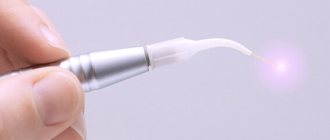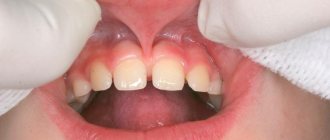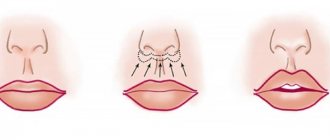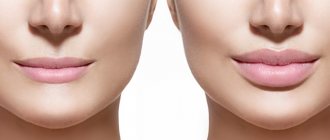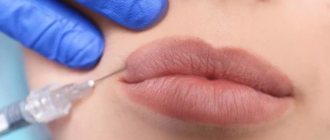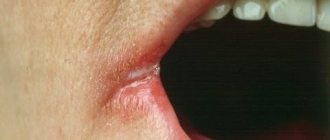What are cleft lip and cleft palate?
Cleft palate (cleft palate, cleft lip, medical name - cheiloschisis) - refers to congenital malformations of the maxillary region of the face. There are some differences between these pathologies.
A cleft lip, or cheiloschisis, (which translates to “splitting”) looks like a cleft in the upper lip, which is sometimes large and affects the nasal cavity.
The cleft palate is an unclosed hard and/or soft palate (cleft palate), resulting in a communication between two cavities - the oral and nasal cavities.
In some cases, a child may have both developmental defects. The approximate ratio of children born with this pathology to healthy babies is 1:2500.
Our patients
Milan
| BEFORE AFTER | Diagnosis: rhinocheiloplasty Attending doctor: Bessonov Sergey Nikolaevich |
Vasilina
| BEFORE AFTER | Diagnosis: rhinocheiloplasty, uranoplasty Attending doctor: Bessonov Sergey Nikolaevich |
Vania
| BEFORE AFTER | Diagnosis: rhinocheiloplasty Attending doctor: Bessonov Sergey Nikolaevich |
Daniel
| BEFORE AFTER | Diagnosis: Bilateral cleft lip |
Nikita
| BEFORE AFTER | Diagnosis: Bilateral cleft lip |
Causes
Soft and hard tissues of the maxillofacial area are formed by the end of the 8th week of pregnancy. The correct formation of these structures is influenced by both hereditary and external factors.
Also, the development of the defect can be influenced by “breakage” of chromosomes. Regardless of the type of defect - cleft palate or cleft lip, the causes of their occurrence are the same.
The share of hereditary factors in the occurrence of cheiloschisis or cleft palate accounts for about 25%.
This issue has not yet been fully studied. Genetics come to the conclusion that the cause of the development of these pathologies is the action of several genes at once. This is also indicated by the fact that the risk of developing cleft palate and cleft lip in subsequent generations is only 7%.
Chromosome abnormalities account for only 15%. In this case, the newborn also has other multiple severe malformations, combined into entire syndromes.
The remaining 40% comes from external pathogenic factors that affected the fetus in the first 2 months of pregnancy. Some factors come directly from the mother's lifestyle and can be easily adjusted:
- smoking during pregnancy, which increases the risk of developing anomalies by 2 times;
- narcotic substances cause cleft lip or cleft palate in children 10 times more often;
- excessive consumption of alcohol and its substitutes;
- the use of certain groups of antiepileptic drugs and antibiotics;
- lack of vitamin B9 (folic acid), which every pregnant girl needs to take, starting from the first weeks of gestation.
There is a group of internal risk factors that, unfortunately, a pregnant woman cannot influence (non-modifiable)
- the age of the pregnant woman is over 35-40 years;
- fetal hypoxia in early pregnancy;
- partial detachment of the chorion, which causes insufficient nutrition of the tiny fetus and inhibits its development.
Where can I get free help for my child?
Knowing how important it is for your baby to receive timely treatment and how much cleft lip surgery costs in a specialized medical center, do not waste time and the opportunity to receive free, qualified help. Surgeons of our Clinic: Professor Bessonov Sergey Nikolaevich and Eremeyshvili Levan Avtandilovich provide consultation and surgical treatment of patients with maxillofacial pathology. Thanks to the support of the “Beautiful Children in a Beautiful World” foundation and Rusfond, medical care within the framework of the “Towards Life” project is free.
To take advantage of our offer, collect a package of necessary documentation from the list and send it to [email protected] for registration. After checking your documents, you will be sent a call for treatment. To confirm the need for surgical treatment, it is worth sending a portrait photograph of the child by mail and then undergo a consultation with Doctor of Medical Sciences S.N. Bessonov or L.A. Eremeyshvili, other specialists and get answers to all your questions by calling tel. 8 (800) 555-84-21 or by filling out the site’s contact form.
You can make an appointment with a specialist by phone: 8 (800) 555-84-21 on weekdays from 9.00 to 19.00 Moscow time Or through the form on the website Sign up for a free consultation
Manifestations of the disease
Despite the causes of the disease, external manifestations are quite typical. Already during the first ultrasound, the expectant mother will be told about the presence and severity of the defect in the baby. So, when such a child is born, a team of doctors will provide him with all the necessary care.
- Cheiloschisis appears as a vertical “gap” in the tissue of the upper lip (see photo above). It may be barely noticeable, or it may extend to the nostril. The lesion can be localized on one side or on both sides at once. Babies may have problems with sucking, so special bottles are used for feeding. Sometimes doctors have to resort to tube feeding.
In the future, children may have problems with teeth (bad bite, missing teeth) and speech (nasal voice and problems with pronunciation).
- A cleft palate in children may not be noticeable upon external examination of a newborn. However, looking into the oral cavity, you can notice a vertical hole in the tissues of the upper palate. From the very first seconds of life, such babies experience problems with breathing and sucking and receive all the necessary help.
In addition to the problems that are typical for cheiloschisis, children with a cleft palate may develop infectious diseases of the ears (otitis) and facial sinuses (sinusitis). This is due to the reflux of inhaled air or liquids from the nasal cavity into the middle ear area.
Ashley Olsen
Source: @ashleyolsens
In 2012, one of the Olsen twins went missing and rumors began to spread about her poor health. It turned out that the girl had contracted Lyme disease. The most difficult thing about the disease is timely diagnosis. Primary symptoms - fever, chills, headache and muscle aches - can easily be confused with the flu or ARVI.
It was only in 2015 that Ashley found out the cause of her condition. Many fans note that now the star looks different - the disease has affected her appearance, the girl seems exhausted. Borelliosis negatively affects the joints, heart, nervous system and vision. However, in 2021, it became known that Olsen’s health had improved, she again began going to the gym and going out.
Types of defects
Two large groups of anatomical defects are classified based on various characteristics.
Classification of cheiloschisis:
- By localization: Defect of the upper lip;
- Defect of the lower lip (extremely rare);
- Defect of the upper and lower lips.
- Unilateral clefting (most often on the left);
- Complete nonunion that extends to the nostril;
- Mild severity (isolated defect of the soft tissues of the lip);
Classification of cleft palate (cleft palate)
The principles for classifying median cleft palate are slightly different.
- By external signs: Obvious cleft (diagnosis is not difficult);
- A hidden cleft, in which there is only a deep muscle defect, and the mucous membrane remains intact. When examining such a newborn, the oral cavity appears normal.
- Incomplete (clefting of the soft palate only);
- One-sided;
Diagnostics
Adequate diagnosis of cleft palate or lip is not very difficult. As already noted, the diagnosis of “cleft palate” and “cleft lip” becomes obvious on ultrasound in the 1st – 2nd trimesters of pregnancy.
An external examination of the newborn allows an accurate diagnosis to be made. However, for a more complete examination, it is sometimes necessary to resort to certain research methods:
- radiography of the maxillofacial area to assess bone defects;
- audiometry or hearing test. It is assessed either with the help of special equipment or by careful observation of the baby (his reaction to auditory stimuli). Necessary for large clefts with a high risk of hearing loss up to deafness;
- examination of the sense of smell (the child’s facial expressions and behavioral reactions to certain categories of strong odors are assessed);
- A general blood test is mandatory for all newborn babies, however, in babies with a defect, special attention should be paid to it. An increase in the level of white blood cells - leukocytes, specific inflammatory proteins (C-reactive protein, ceruloplasmin) and an acceleration of the erythrocyte sedimentation rate (ESR) indicate the addition of an infection, which can be quite difficult in weakened children.
Yolanda Hadid
Source: @yolanda.hadid
The famous model released the book “Believe Me: My Battle with the Invisible Disability of Lyme Disease” in 2021. She now claims that the disease is in remission and she feels much better. But in 2012, when she was first diagnosed, Yolanda complained of constant joint pain and fatigue. She even had suicidal thoughts.
“There are difficult days when you sleep for 12 hours, wake up at 11 and can’t get out of bed because of severe joint pain, brain fog, anxiety,” she shared her feelings. Many doctors believe that the symptoms of borelliosis can be easily controlled with timely treatment, but some patients, even after a course of antibiotics, may experience post-Lyme syndrome, which lasts up to six months.
Treatment of pathology
The main treatment method for these pathologies is surgery.
Surgery for cleft lip is called cheiloplasty. Most often, it is performed closer to 6 months of age, however, in some cases, the baby may require urgent surgery (during the first month of life).
This is usually associated with extensive defects.
Depending on the affected tissues, perform:
- Isolated cheiloplasty – stitching of the skin, subcutaneous tissue, muscle layer and mucous membrane of the lips;
- Rhinocheiloplasty (Latin “rino” – nose) – additional correction of nasal cartilage;
- Rhinognathocheiloplasty – formation of the muscular frame of the mouth area.
Unfortunately, surgical intervention alone cannot be done. In the first 3 years of life, the baby will have to lie on the operating table 3-4 times.
The successes in the treatment of cheiloschisis are enormous. In most cases, the child is left with only slight lip asymmetry and a barely noticeable scar. And already in adulthood, a person will be able to contact a cosmetologist who will help eliminate minor defects.
Forecast
The prognosis is very favorable. Thanks to modern methods of surgical plastic surgery, orthopedics and speech therapy, children with a similar diagnosis are almost no different from those around them and lead absolutely fulfilling lives. It is important to approach the child’s long-term treatment and rehabilitation with all seriousness.
At an early age, babies can have problems with feeding and weight gain, and, accordingly, with neuropsychic development. Therefore, you should master specialized feeding techniques and use additional sources of nutrients (energy complexes, vitamins).
Even with successful correction of the defect, the child is advised to undergo regular observation by specialists - a maxillofacial surgeon, a neurologist, an otolaryngologist and an orthodontist. The child will visit these doctors at least once a year until he is 17-19 years old, until all the tissues of the maxillofacial area are fully formed.
Bella Hadid
Source: @bellahadid
Yolanda's daughter Bella also faced the disease. Some people question the fact that several people in a family can have this diagnosis, but the model continues to share her feelings with the public. She doesn't like it when her illness is considered a fiction. She once published a list of symptoms of someone infected with borelliosis in Stories and noted the points that she encounters every day - there were 30 of them.
Among the symptoms that prevent Bella from living fully are headaches, acute reactions to noise and bright light, tachycardia and difficulty breathing, increased sweating. Despite this, she works hard and remains one of the most sought-after models of our time.
Bella claims that the disease was diagnosed at the age of 14, but at 18 it began to worsen. She had to stay on IV drips to recover faster.
